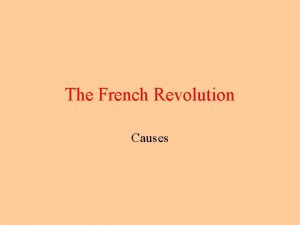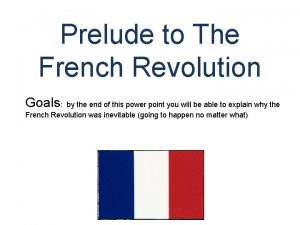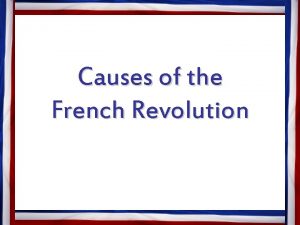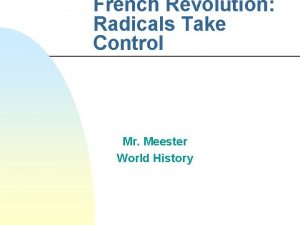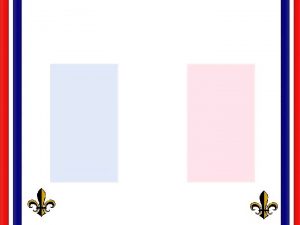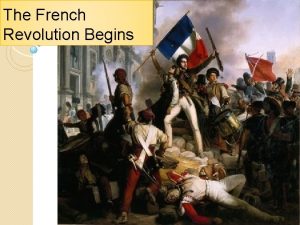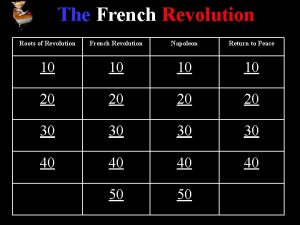The French Revolution The Old Regime or Old













- Slides: 13

The French Revolution

The Old Regime or Old Order • France was ruled by Louis XVI and his wife Queen Marie Antoinette • France was an advanced and prosperous nation • Beneath this was unrest caused by bad harvests, high prices, high taxes and questions raised by the Enlightenment • There were severe economic problems in France

French Class Structure The Privileged Estates • The first Estate was the Roman Catholic clergy • The church owned 10 percent of all land in France • The clergy had access to high offices in the government • The church paid about 2 percent of its income to the government

The Second Estate • Made up of wealthy nobles • Was about 2 percent of the total population • Owned 20 percent of the land paid no taxes • Rejected Enlightenment ideas as radical and threatening to their status and power

The Third Estate • 97 percent of the population belonged to the third Estate • Consisted of three groups: Bourgeoisie - were middle class, well educated merchants, factory owners, professionals and skilled artisans Workers - formed the second group within the Third Estate Peasants - formed the largest group within the Third Estate, about 80 percent of France’s 26 million people

Forces of Change and Weakened Leadership • • • Growing resentment of lower classes contributed to the revolutionary mood in France New ideas about government from the Enlightenment were spreading among the Third Estate, “equality , liberty, democracy” France’s once prosperous economy had been strangled by tax burdens Louis XVI and Queen Marie Antoinette borrowed huge sums to fund the American Revolution, continue their extravagant lifestyles and pay debts Louis had inherited Louis XVI was a weak leader who allowed the debt to become a serious problem The heavy tax burden on the Second Estate forced Louis XVI to summon a meeting of the Estates General, an assembly of representatives from all three estates to approve of the new taxes

Estates General and the Beginning of the Revolution • • Estates General was dominated by the First and Second Estates, the two privileged Estates, they could out-vote the Third Estate wanted equality in the Estates General and equality in voting with the other two Estates, giving the Third Estate a larger voice in the government King Louis XVI sided with the nobles and clergy and insisted that the Estates General follow their medieval rules The Third Estate bolted from the gathering and declared that the Third Estate’s new National Assembly was legitimate and would make the laws

Tennis Court Oath • • The Third Estate voted on June 17, 1789 to establish the National Assembly which was a vote to end the absolute monarchy and begin representative government The Estates General responded by locking the Third Estate out of the meeting hall The Third Estate pledged to stay on in a makeshift chamber, a tennis court, where members signed the pledge, known as The Tennis Court Oath Louis XVI reacted to these events by surrounding the Palace at Versailles with his mercenary army of Swiss guards

French Revolution • Fear and rumors of repression sent citizens of Paris to the streets • On July 14, 1789 a group searching for weapons and gunpowder stormed the Bastille, a Paris prison • Fall of the Bastille became a great symbolic act of the revolution to the French people and is still celebrated today on July 14 th as Bastille Day

Great Fear • • Rebellion quickly spread throughout France Peasants throughout the land stormed and burned noble’s manor houses In October, 1789 Parisian women rioted over the rising price of bread and stormed the Palace at Versailles “let them eat cake” the famous quote allegedly from Marie Antoinette about the women rioters Louis XVI and his family left Versailles for Paris Fearing for their lives and property, the First and Second Estates joined with members of the National Assembly to swept way their privileges – the Old Regime was dead Nobles and members of the First and Second Estates agreed to the changes out of fear rather than true commitment to the revolution

Assembly Reforms France • • It issued the Declaration of the Rights of Man and of the Citizen, “men are born free and remain free and equal in rights” Guaranteed citizens equal justice, freedom of speech, and religion Adopted the expression "Liberty, Equality, Fraternity” Confiscated church lands and sold them and ordered that priests were to be elected and paid as state officials Devoted Catholic peasants were offended by the combining of the church and state In June of 1791 Louis XVI and his family were captured trying to escape to Austria and returned to Paris under armed guard The national Assembly set up a constitution that established a constitutional monarchy The National Assembly split into three groups: left, right and center politically

War and Execution • • Fearful monarchs in Europe sought to reign in France and wanted Louis XVI reinstated as an absolute monarch The legislative Assembly responded by declaring war on Austria and Prussia Mobs took to the streets killing nobles and priests Louis XVI and family were imprisoned A new government was formed amid the chaos The new government was called the National Convention. Led by a group known as Jacobins and their radical leader Jean-Paul Marat The convention tried Louis XVI for treason, convicted and executed Louis XVI on January 21, 1793 by guillotine (a new execution devise invented during the French Revolution by a doctor)

Reign of Terror • • • Jacobins leader Robespierre gained control and power In July, 1793 he became virtual dictator of France He used the Committee of Public Safety to try and execute enemies of the state Many people died, most by the guillotine, including Marie Antoinette An estimated 40, 000 people were executed during the Reign of Terror Members of the national Assembly began to fear for their own lives and turned on Robespierre and had him executed on July 28, 1794 ending the Reign of Terror Moderate leaders drafted a new plan of government in 1795, the third since 1789 The new government , know as the Directory, consisted of a two-house legislature and an executive branch made up of five men known as the Directory Order was finally brought to France
 Old regime french revolution
Old regime french revolution How could the french revolution have been avoided
How could the french revolution have been avoided Russian revolution vs french revolution
Russian revolution vs french revolution Old regime 3 estates
Old regime 3 estates What is the old regime in france
What is the old regime in france Third agricultural revolution definition
Third agricultural revolution definition Outcome of french revolution
Outcome of french revolution What factors led to the french revolution
What factors led to the french revolution Tennis court oath ap world history
Tennis court oath ap world history French revolution causes and effects
French revolution causes and effects French revolution
French revolution Storming of the bastille cartoon
Storming of the bastille cartoon Sophie of france (1786-1787)
Sophie of france (1786-1787) Radicals take control french revolution
Radicals take control french revolution
